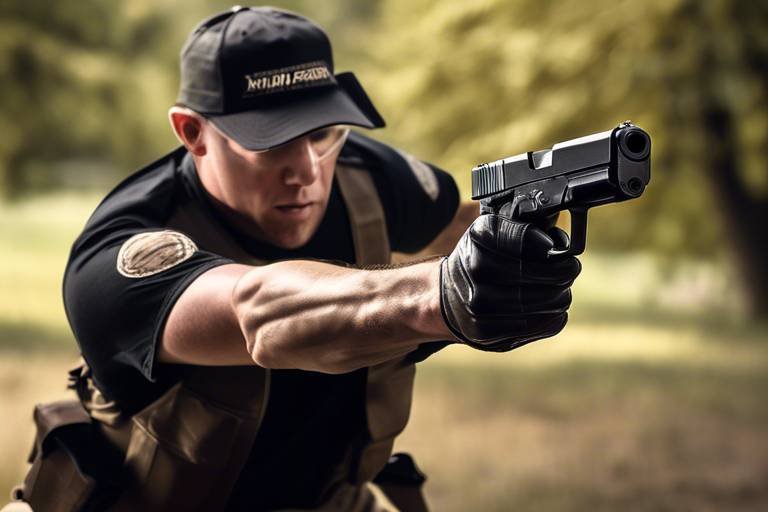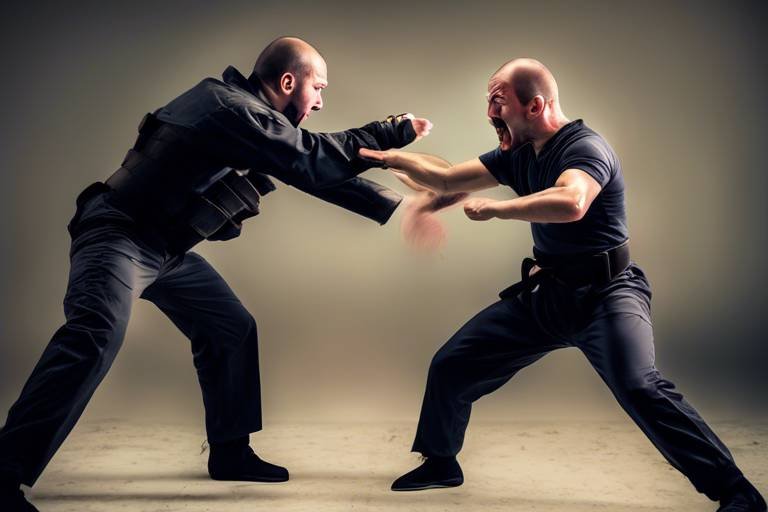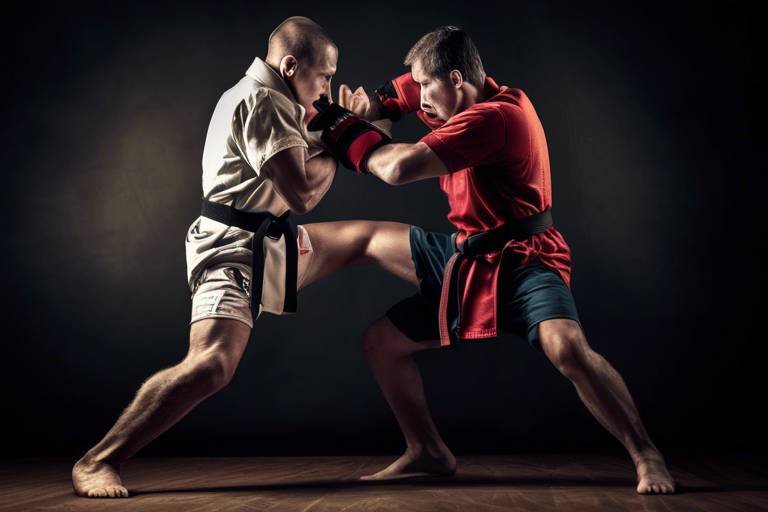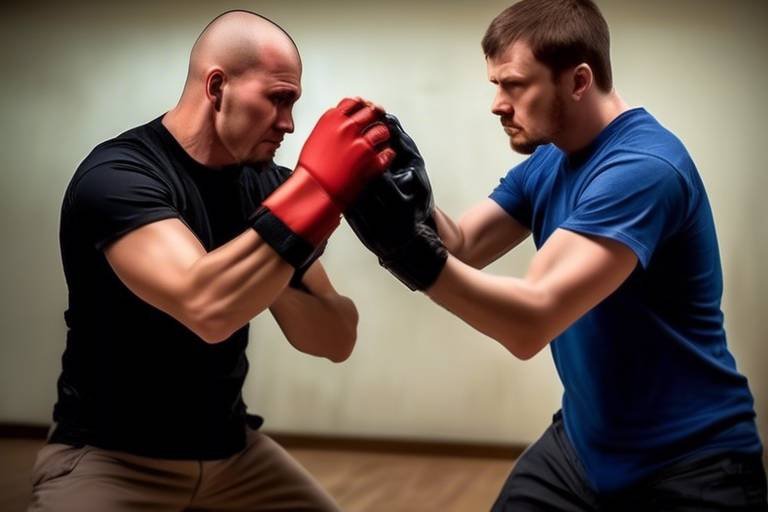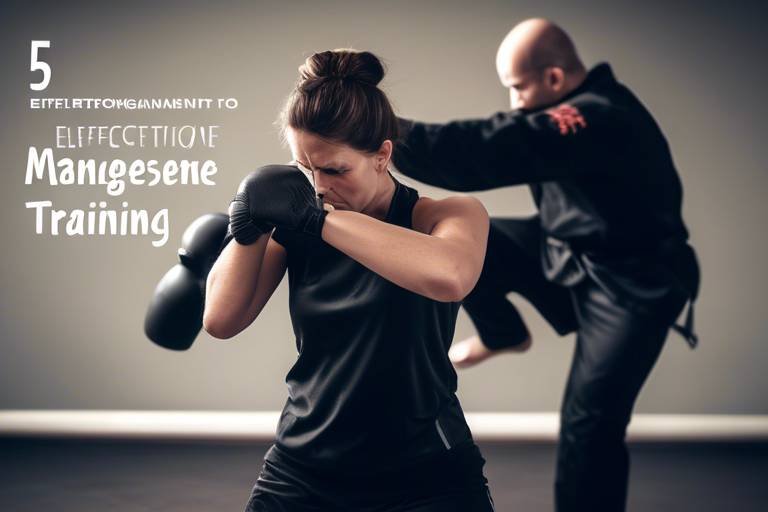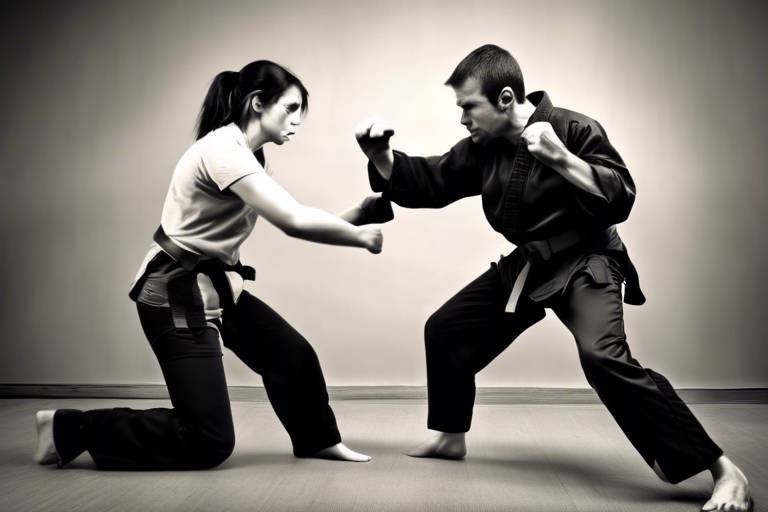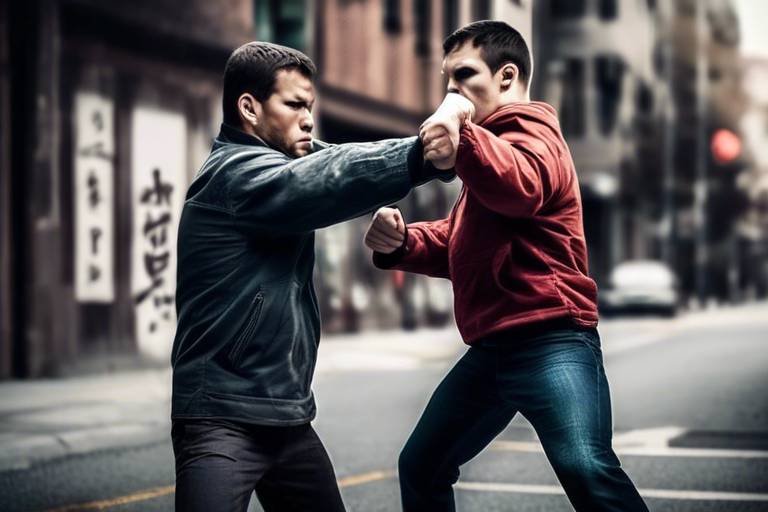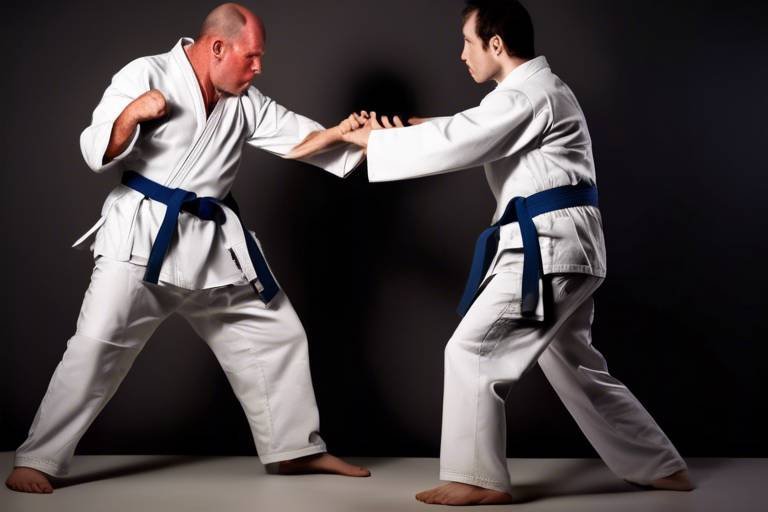How to Use the Environment to Enhance Your Self-Defense Techniques?
Self-defense isn't just about knowing how to throw a punch or execute a perfect kick; it's about being aware of your surroundings and using them to your advantage. Imagine walking down a street, and suddenly you sense that something isn't right. What do you do? Do you freeze, or do you tap into your instincts and the environment around you? In this article, we will explore the myriad ways you can leverage your surroundings to enhance your self-defense skills. From recognizing potential threats to utilizing natural obstacles, we'll cover practical tips and strategies that can turn any environment into a safe haven or a battleground, depending on how you choose to navigate it.
Being aware of your environment is crucial for self-defense. It’s not just about seeing what's in front of you; it’s about understanding the dynamics of your space. Think of it like playing chess. Every piece on the board has a role, and so does every element in your environment. Start by assessing your surroundings. Are there people nearby? What are they doing? Is there an escape route if things go south? Identifying potential threats or safe zones can make a world of difference. For instance, if you're in a crowded area, look for exits, or if you're in a park, notice the trees and benches that could provide cover or a quick getaway.
Natural obstacles like trees, rocks, and even bushes can serve as effective shields or barriers in a confrontation. Picture this: you’re in a park, and someone approaches you aggressively. Instead of panicking, you can quickly position yourself behind a tree, using it as a shield while you assess the situation. This natural cover can buy you precious seconds to think or escape. Moreover, rocks can be used not just as barriers but as tools for distraction. Throwing a small stone in a different direction can divert an aggressor's attention, allowing you to slip away unnoticed.
Different terrains present unique opportunities for self-defense. Whether you find yourself on flat ground, hills, or uneven surfaces, adapting your techniques is key. For example, if you’re on a hill, you have the advantage of height. You can see potential threats coming from a distance, and if necessary, you can leverage gravity to your advantage during a confrontation. On the other hand, uneven surfaces can be tricky. If you're in a rocky area, be mindful of your footing. The last thing you want is to trip while trying to defend yourself. Always be aware of how the terrain can either aid or hinder your movements.
In urban settings, various structures can be utilized for self-defense. Think about buildings, alleys, and vehicles. If you’re confronted in an alley, you can use the walls to your advantage, positioning yourself so that your back is protected. Vehicles can also serve as barriers or cover. If you’re near a car, you can duck behind it to shield yourself from an aggressor. Moreover, urban environments often have more people around, which can be beneficial. Making noise or calling for help can attract attention and deter a potential attacker.
Rural areas offer distinct challenges and advantages. Open spaces can feel intimidating, but they also provide room to maneuver. If you’re on a farm, think about using the landscape to your advantage. Barns can provide cover, and tools can be improvised as self-defense weapons. Wooded areas can be tricky, but they offer natural camouflage. If you find yourself in a confrontation, use the trees to hide or escape. Always remember, nature is not just a backdrop; it can be your ally in a self-defense scenario.
Every environment has potential improvised weapons. You'd be surprised at how many ordinary items can be turned into powerful tools for self-defense. A pen can be a striking tool, while a belt can be used to create distance. Even something as simple as a water bottle can be used to distract an assailant. The key is to think creatively and remain calm under pressure. When you’re aware of your surroundings, you’ll start to see everyday objects as potential assets, rather than just items you carry.
Cultivating situational awareness is essential for self-defense. It’s about being tuned in to your environment and recognizing when something feels off. Techniques to enhance your perception include regularly scanning your surroundings and staying alert to changes. If you notice someone following you, trust your instincts. It’s better to be cautious than to ignore your gut feeling. By practicing situational awareness, you can spot potential threats before they escalate, giving you the upper hand.
Identifying potential threats before they escalate is vital. Look for warning signs such as aggressive body language or someone who seems overly interested in your movements. Trust your instincts; if something feels wrong, it probably is. Being aware of your surroundings allows you to assess risk factors effectively. For example, if you’re in a group, be mindful of individuals who are isolated or acting suspiciously. Recognizing these signs can help you avoid dangerous situations altogether.
Knowing how to react when confronted is crucial. Your response should be based on the environment and the nature of the threat. In some cases, it might be best to escape, while in others, you may need to defend yourself. Always prioritize your safety and the safety of others. If you find yourself in a situation where confrontation is unavoidable, remember to use your environment to your advantage, whether it’s finding an escape route or utilizing nearby objects as shields or weapons.
- What should I do if I feel threatened in a public place? Trust your instincts, seek help from nearby individuals, and look for an escape route.
- Can everyday items really be used for self-defense? Absolutely! Items like pens, keys, and even bags can be effective tools in a self-defense situation.
- How can I improve my situational awareness? Practice scanning your surroundings regularly and stay alert to changes in your environment.
- What if I’m in a rural area and feel unsafe? Use the landscape to your advantage, find cover, and seek help if possible.

Understanding Your Surroundings
When it comes to self-defense, one of the most critical skills you can develop is the ability to understand your surroundings. Imagine walking down a street, and suddenly you feel a presence behind you. What do you do? Your first instinct might be to panic, but instead, you should be assessing the environment around you. Being aware of your surroundings isn't just about looking out for potential threats; it's also about identifying escape routes, potential allies, and even objects that can help you in a pinch.
Start by scanning your environment. Look for places to hide or escape if necessary. Are there any exits nearby? How about a crowd you can blend into? Being aware of these elements can make a world of difference in a tense situation. You can also identify potential threats by observing people's behavior. Are they acting suspiciously? Do they seem out of place? These are crucial indicators that can help you gauge whether to stay put or move on.
Another essential aspect is knowing the layout of the area you are in. For example, if you're in a familiar neighborhood, you should already have a mental map of the streets and buildings. This knowledge allows you to make quick decisions. However, if you're in a new area, take a moment to familiarize yourself with your surroundings. Look for landmarks, street names, and anything that can help you navigate should you need to escape.
In addition to physical surroundings, consider the time of day and the level of activity in the area. For instance, a bustling street during the day is typically safer than a deserted alley at night. The more people around, the less likely someone will attempt to harm you. However, large crowds can also be overwhelming, so it’s essential to find a balance between safety in numbers and the ability to maneuver.
Understanding your surroundings also involves being aware of natural elements. For example, if you're in a park, trees and benches can serve as cover or barriers. If you're near a body of water, that can also change your dynamics. Think of the environment as a chessboard; each piece (or element) can either help you or hinder you. The key is to recognize what’s at your disposal and how you can use it to your advantage.
In summary, enhancing your self-defense skills starts with a keen awareness of your surroundings. By taking the time to observe and understand your environment, you empower yourself to respond more effectively to potential threats. Remember, the goal is not just to react but to anticipate and prepare. So next time you step outside, make it a habit to assess your surroundings actively. It could be the difference between safety and danger.
- What should I do if I feel threatened in my surroundings?
If you feel threatened, trust your instincts. Look for an escape route, try to blend into a crowd, or find a safe place to call for help.
- How can I improve my situational awareness?
Practice being observant in everyday situations. Pay attention to people's behavior and the layout of the places you frequent.
- What are some common environmental features I can use for self-defense?
Natural obstacles like trees, rocks, and benches can provide cover. In urban settings, vehicles and buildings can serve as shields.

Utilizing Natural Obstacles
When it comes to self-defense, leveraging your environment can make a significant difference in the outcome of a confrontation. One of the most effective ways to do this is by utilizing natural obstacles such as trees, rocks, and other elements found in nature. Imagine being in a situation where you feel threatened; instead of panicking, you can quickly scan your surroundings and use what’s available to create a barrier between you and the aggressor. This not only provides you with a shield but also gives you time to think and plan your next move.
Natural obstacles can serve multiple purposes in a self-defense scenario. For instance, a large tree can act as a physical barrier, preventing an attacker from reaching you while also offering you a chance to hide. Similarly, boulders or large rocks can be used to shield yourself from view, making it harder for an aggressor to track your movements. The key is to remain aware of your environment and to practice situational awareness, so you can quickly identify these potential shields when needed.
Consider this: if you’re in a wooded area, the trees can be your best friends. You can duck behind them, use them to block the line of sight, or even use branches to create a distraction. In contrast, if you find yourself near a rocky terrain, you can utilize the uneven surfaces to your advantage. The unpredictability of the terrain can confuse an attacker, giving you the upper hand. Adaptability is crucial in these situations; the more you practice recognizing and using these natural elements, the more instinctive your responses will become.
Moreover, it’s essential to think creatively about how to use these obstacles. For example, if you’re near a body of water, it can serve as a natural deterrent. An attacker may hesitate to approach you if there’s a risk of slipping or falling in. Similarly, if you’re in an area with dense foliage, you can use it to create a visual barrier, making it difficult for someone to track your movements. The more you familiarize yourself with your surroundings, the more options you’ll have at your disposal.
| Natural Obstacles | Potential Uses |
|---|---|
| Trees | Provide cover, act as barriers |
| Rocks | Shield from view, create distractions |
| Bodies of Water | Deterrent for attackers, escape routes |
| Dense Foliage | Visual cover, hiding spots |
Ultimately, the ability to utilize natural obstacles effectively can greatly enhance your self-defense techniques. It’s not just about physical strength; it’s about being smart and strategic. Always remember, the environment is your ally. By training yourself to recognize and use these natural elements, you can turn a potentially dangerous situation into one where you have the advantage. So, the next time you’re out in nature, take a moment to consider how you would use the surroundings to protect yourself. It could make all the difference.

Using Terrain to Your Advantage
When it comes to self-defense, the terrain can be your greatest ally or your worst enemy. Imagine standing on a flat, open field versus being on a rocky hillside. These environments can drastically change your approach to a confrontation. By understanding how to use different terrains to your advantage, you can enhance your self-defense techniques significantly. So, let’s dive into how you can adapt your strategies based on the ground beneath your feet.
First off, let's talk about flat surfaces. While they might seem straightforward, they can actually work to your advantage by providing ample space to maneuver. If you find yourself in an open area, consider using your agility and speed. You can create distance between you and a potential threat, making it harder for them to reach you. Moreover, you can also use the environment to create barriers. For instance, if there are benches or other obstacles, use them to shield yourself while you look for an escape route.
Now, what about hilly or uneven terrain? This type of environment can be tricky, but it also offers unique opportunities. When on a slope, gravity can be your friend. If you need to escape, running downhill can give you a speed advantage. Conversely, if you’re faced with an aggressor, using the incline can help you maintain your balance while making it harder for them to keep up. Just remember, the key is to stay aware of your footing; one wrong step could lead to a fall, which might put you in a more vulnerable position.
In contrast, navigating through rough or rocky terrain requires a different mindset. Here, your focus should be on using the environment to create obstacles for your attacker. For example, if you're in a wooded area, use trees to obstruct their path or to hide your movements. The natural cover can provide you with the element of surprise, allowing you to evade or counterattack effectively. Plus, the uneven ground can slow down an aggressor, giving you a crucial advantage.
Lastly, let’s not forget about urban environments, where the terrain is often man-made. Cityscapes are filled with opportunities to use structures to your benefit. Think of alleys, parked cars, and even street furniture as potential shields. For instance, if you’re being pursued, ducking behind a car can provide you with a moment to collect your thoughts and plan your next move. Urban areas often have many escape routes, so always be aware of your options and think creatively about how to use the space around you.
In summary, the terrain you find yourself in can significantly impact your self-defense strategy. By understanding how to leverage flat surfaces, hills, rocky areas, and urban structures, you can turn any environment into a tactical advantage. Always be aware of your surroundings, and remember that with a little creativity, you can use the ground beneath your feet to enhance your personal safety.
- How can I improve my situational awareness? Regularly practice observing your environment and noting potential escape routes and threats.
- What should I do if I can't escape my attacker? Use your surroundings creatively to create barriers or obstacles, and look for improvised weapons.
- Are there specific techniques for different terrains? Yes, adapting your movement and strategy based on the terrain is crucial for effective self-defense.

Urban Environments
When it comes to self-defense, urban environments present a fascinating mix of opportunities and challenges. The concrete jungle is filled with potential allies and adversaries, and understanding how to navigate this complex landscape can significantly enhance your personal safety. Think about it: every street corner, alleyway, and building can either be a safe haven or a potential trap. So, how can you turn the bustling city into your fortress?
First and foremost, awareness of your surroundings is key. In an urban setting, you should always keep your head up and your eyes open. Look for escape routes, potential hiding spots, and even places to seek help if needed. For instance, if you're walking down a street and notice a group of individuals loitering, assess whether it's safer to cross the street or continue on your path. Small decisions like these can make a world of difference.
Buildings, vehicles, and street furniture can serve as invaluable tools in your self-defense arsenal. For example, if you find yourself in a threatening situation, consider using a parked car as a barrier between you and your aggressor. You can duck behind it for cover while planning your next move. Similarly, doorways can be used to create distance between you and a potential threat. By stepping into a doorway, you can shield yourself while also having the option to retreat into a building if necessary.
Moreover, understanding the layout of your environment can give you a tactical advantage. Here are a few strategies to consider:
- Utilize alleys: While they can be risky, alleys can also provide a quick escape route.
- Know your exits: Familiarize yourself with the exits in buildings you frequent, such as restaurants or shops.
- Use crowds: In busy areas, blend in with crowds to make yourself less noticeable to potential threats.
Another aspect to consider is the use of urban elements as improvised weapons. Think about it: a pencil can become a tool for defense, a heavy bag can be swung to create distance, or even a hot cup of coffee can serve as a temporary distraction. The key is to remain creative and resourceful with what’s around you. Remember, it’s not about being a martial arts expert; it’s about using your environment to your advantage.
In summary, urban environments can be both daunting and empowering. By enhancing your situational awareness, understanding how to utilize structures and objects around you, and thinking creatively, you can turn the city into a space where you feel safer and more confident. Always remember, the best defense is often a good offense—so stay alert, stay prepared, and don't hesitate to use your surroundings to protect yourself.

Rural Environments
When it comes to self-defense in , the landscape can be both a blessing and a curse. Unlike urban settings, where you're surrounded by concrete and people, rural areas often provide vast open spaces, dense woods, and natural barriers. This can create unique opportunities for self-defense, but it also presents distinct challenges. Imagine walking through a quiet forest; the tranquility can quickly turn into a tense situation if you find yourself confronted by a potential threat. Understanding how to navigate these environments is crucial for your safety.
One of the key advantages of rural settings is the abundance of natural cover. Trees, bushes, and even the terrain itself can serve as effective shields. For instance, if you're approached by someone with ill intentions, ducking behind a tree or crouching in a thicket can give you precious seconds to assess your situation or make a quick escape. Additionally, the uneven ground can be used to your advantage; a sudden change in elevation can throw off an attacker’s balance, giving you an edge.
However, rural environments also have their downsides. The vastness can make it difficult to find help quickly. In an emergency, cell service might be spotty or nonexistent, and the nearest neighbor could be miles away. This is why it's essential to have a plan in place. Familiarize yourself with your surroundings, and take note of potential escape routes. For example, if you know a nearby road or trail leads to safety, make a mental note of it. In rural areas, being aware of your environment can be the difference between safety and danger.
Another important aspect is the use of available resources. In rural settings, everyday items can become improvised tools for self-defense. A sturdy branch can serve as a makeshift weapon, while a rock can be thrown to distract an attacker or create a diversion. It’s all about being resourceful. Think of your surroundings as a toolkit; everything you see can potentially be used to your advantage. In fact, many self-defense techniques emphasize the importance of using what you have at hand, turning the ordinary into something extraordinary.
Moreover, the rural landscape can also provide a sense of isolation, which can be both comforting and concerning. While it may feel safe to be away from the hustle and bustle of the city, isolation can make you more vulnerable. It’s essential to stay vigilant and trust your instincts. If something feels off, don’t hesitate to leave the area or seek help. Always remember, your safety is the top priority.
In summary, navigating rural environments for self-defense requires a blend of awareness, resourcefulness, and a solid understanding of your surroundings. By leveraging natural obstacles, being prepared for the unique challenges of open spaces, and improvising with available objects, you can significantly enhance your personal safety. The key is to stay alert, trust your instincts, and be ready to adapt to whatever situation arises.
- What should I do if I feel threatened in a rural area? Trust your instincts, look for an escape route, and seek help if possible.
- How can I improve my situational awareness in rural environments? Regularly assess your surroundings, practice mindfulness, and stay alert to changes in your environment.
- Are there specific self-defense techniques for rural settings? Yes, techniques that utilize natural cover and improvised weapons can be particularly effective.

Improvising with Available Objects
In the world of self-defense, improvisation can be your best friend. You might find yourself in a situation where traditional self-defense tools are unavailable, but that doesn’t mean you’re defenseless. The key is to look around and see how everyday objects can be transformed into effective self-defense tools. Think of your environment as a treasure chest filled with potential weapons, just waiting for you to discover them.
Let's dive into a few common objects you can easily find in various environments. For instance, a pen can be a fantastic tool for self-defense. Not only is it lightweight and easy to carry, but it can also be used to jab at an attacker or to apply pressure to sensitive areas. Similarly, a keychain can be turned into a makeshift weapon. By holding it between your fingers, you can use it to strike or defend yourself against an aggressor. It’s amazing how something so mundane can become a lifeline in a tough situation.
Other objects like umbrellas and bags can serve dual purposes. An umbrella can be used to block an attack or even to strike, while a bag can be swung to create distance between you and a potential threat. Even your phone can come in handy; not only can it be used to call for help, but it can also be thrown to distract an attacker, giving you a critical moment to escape.
Here’s a quick rundown of some common objects and their potential uses:
| Object | Possible Use |
|---|---|
| Pen | Jabbing, pressure points |
| Keychain | Striking, self-defense |
| Umbrella | Blocking, striking |
| Bag | Creating distance, swinging |
| Phone | Calling for help, distraction |
When it comes down to it, the best way to prepare for a self-defense situation is to practice thinking on your feet. Try to visualize different scenarios and consider what objects you could use in each case. The more you train your brain to recognize these opportunities, the more instinctively you will react in a real situation. Remember, self-defense isn’t just about physical techniques; it’s also about being resourceful and adaptable. So, the next time you step outside, take a moment to scan your environment and think about how you could use what’s around you to your advantage.
- What should I do if I have no objects available for self-defense?
Focus on your body’s natural defenses, such as striking vulnerable areas like the eyes, throat, or groin. Use your voice to attract attention and draw help.
- Are improvised weapons legal to use in self-defense?
It varies by location. Generally, using reasonable force to protect yourself is legal, but check local laws regarding self-defense and the use of objects.
- How can I practice using everyday objects for self-defense?
Consider taking a self-defense class that incorporates improvised weapons. You can also practice at home with common items to build confidence in your skills.

Situational Awareness
Situational awareness is like having a sixth sense in a world full of distractions. It's the ability to perceive your surroundings, understand what’s happening around you, and anticipate potential threats before they escalate. Imagine walking through a crowded street; instead of being lost in your phone, you’re scanning the area, noticing the people, the exits, and any unusual behaviors. This skill can be a game-changer when it comes to self-defense.
To cultivate this awareness, start by training your mind to observe. Look for things that seem out of place or people who aren’t acting normally. For instance, if you’re in a park and notice someone lingering too long in the same spot, it could be worth paying extra attention to that individual. You can enhance your situational awareness by practicing the following techniques:
- Scan Your Environment: Regularly take a mental note of your surroundings. What’s in front of you? Behind you? To your sides? This helps you create a mental map.
- Identify Exit Routes: Whether you’re in a building or outdoors, always be aware of your escape options. Knowing where to go can save crucial seconds in an emergency.
- Trust Your Instincts: If something feels off, it probably is. Don’t ignore that gut feeling; it’s often your brain picking up on subtle cues.
Additionally, enhancing your situational awareness isn’t just about being observant; it also involves understanding the context of your environment. Different places come with different risks. For example, a busy shopping mall might have more potential distractions and less immediate danger than a dimly lit parking lot. By recognizing these nuances, you can adjust your mindset and actions accordingly.
Moreover, consider the time of day and weather conditions. Nighttime can obscure visibility, while rain might make surfaces slippery. These factors can influence both your awareness and your ability to respond effectively. It’s like playing a video game where the environment changes the rules; you need to adapt your strategy based on what’s happening around you.
Incorporating technology can also enhance your situational awareness. Apps that provide real-time safety alerts or neighborhood watch notifications can keep you informed about potential threats in your area. However, don’t rely solely on technology; it should complement your instincts and observations, not replace them. Remember, the best defense is a well-prepared mind that’s always alert.
Identifying potential threats is a critical aspect of situational awareness. It’s about being proactive rather than reactive. Look for warning signs such as:
- Unusual behavior from individuals, such as pacing or excessive fidgeting.
- Groups of people congregating in a way that seems suspicious.
- Situations where someone is trying to isolate another person.
By recognizing these signs early, you can take steps to avoid confrontation or prepare yourself mentally for a potential escalation. It’s like being a detective, piecing together clues before the mystery unfolds.
When faced with a threat, your response should be swift and calculated. The key is to remain calm and assess the situation. Ask yourself questions like: “What are my options?” and “How can I safely escape?” Your response will vary based on the environment. For instance, in a crowded area, creating distance might be your best bet, while in a more secluded place, finding a way to defend yourself or call for help could be necessary.
In conclusion, situational awareness is not just a skill; it’s a mindset. By training yourself to be observant, trusting your instincts, and understanding your environment, you enhance your personal safety significantly. It’s all about being prepared for whatever life throws your way. So, the next time you step outside, remember: stay alert, stay aware, and stay safe!
| Question | Answer |
|---|---|
| What is situational awareness? | Situational awareness is the ability to perceive and understand your surroundings, allowing you to anticipate potential threats and respond effectively. |
| How can I improve my situational awareness? | You can improve it by regularly scanning your environment, identifying exit routes, and trusting your instincts when something feels off. |
| Why is situational awareness important for self-defense? | It allows you to detect potential threats early, giving you the chance to avoid dangerous situations or prepare yourself to respond effectively. |

Recognizing Threats
Recognizing threats in your environment is like having a sixth sense; it’s about tuning in to the subtle cues that often go unnoticed. Imagine walking down a street and feeling a shift in the atmosphere, like a sudden chill that makes the hairs on the back of your neck stand up. This instinctive awareness can be a game-changer when it comes to self-defense. The key is to remain vigilant and observant, ready to pick up on the signs that something might be off.
To effectively identify potential threats, you need to cultivate a habit of scanning your surroundings regularly. This includes not just looking at people, but also paying attention to their body language, the way they move, and even the context of the situation. For example, if you see a group of individuals acting aggressively or loitering in a way that feels suspicious, trust your gut. Your intuition is often your first line of defense.
Here are some critical warning signs to watch for when assessing your environment:
- Body Language: Look for aggressive postures, clenched fists, or individuals who are invading personal space.
- Unusual Behavior: Notice if someone is acting out of character, such as someone pacing back and forth or glancing around nervously.
- Environmental Changes: Pay attention to sudden changes in the atmosphere, like an abrupt silence in a usually noisy area.
- Grouping of Individuals: Be cautious of groups that seem to be watching or following you.
Moreover, understanding the context of your surroundings is equally important. For instance, in a crowded area, a person behaving oddly may be less of a threat than in a secluded location. The environment plays a crucial role in threat assessment. Always consider the location—are you in a familiar neighborhood or a new area? Are there escape routes or places to hide? These factors can significantly influence your level of risk.
Another aspect of recognizing threats is to be aware of your own distractions. In our fast-paced world, it's easy to get lost in our phones or headphones, but this can blind you to potential dangers. Try to limit distractions and keep your senses sharp. Think of it like driving; you wouldn’t text while navigating a busy road, right? The same principle applies to being aware of your surroundings.
Finally, remember that recognizing threats is not just about being paranoid; it’s about being prepared. Cultivating this awareness can empower you to take proactive measures, whether that means avoiding a potentially dangerous situation or being ready to defend yourself if necessary. Trust yourself, stay alert, and always have a plan. After all, the best defense is a good offense, and being aware of your environment is the first step in that direction.

Responding to Threats
When it comes to self-defense, knowing how to respond to threats is just as crucial as the techniques you employ. Imagine you're walking down a quiet street, and suddenly, you sense someone following you. Your heart races, and your mind starts to whirl with possibilities. What do you do? The first step is to assess the situation. Understanding your options can mean the difference between safety and danger.
One of the most effective ways to respond to a threat is to remain calm and composed. Panic can cloud your judgment, making it harder to think clearly. Take a deep breath and focus on your surroundings. Are there any escape routes? Is there a nearby place where you can seek help? Situational awareness is your best ally here. By staying alert, you can evaluate your options and make informed decisions.
In many cases, your response will depend on the nature of the threat. For instance, if you feel that the situation is escalating and you are in immediate danger, it might be necessary to take a defensive stance. This could mean positioning yourself in a way that allows you to protect vital areas of your body while preparing to either escape or defend yourself. Remember, the goal is to create distance between you and the threat.
When faced with a potential assailant, consider the following responses:
- De-escalation: If the threat is verbal or non-physical, try to defuse the situation with calm communication. Sometimes, acknowledging the other person can ease tensions.
- Escape: If there’s a clear path to safety, take it. Running away is not a sign of weakness; it’s a wise choice when faced with danger.
- Defend: If you cannot escape and the threat becomes physical, use your surroundings to defend yourself. This could involve using natural obstacles or improvised weapons to create a barrier or fend off an attacker.
Another crucial aspect of responding to threats is knowing when to seek help. If you find yourself in a situation that feels unsafe, don’t hesitate to call the authorities or alert someone nearby. In urban environments, this might mean heading towards a crowded area or entering a store where you can ask for assistance. In rural settings, look for any signs of habitation or fellow pedestrians.
Ultimately, your response to a threat should be guided by the principle of protecting yourself while minimizing risk. Always prioritize your safety and remember that you have the right to defend yourself. Consider practicing your responses in a safe environment, like a self-defense class, which can help you react more instinctively in real-life situations.
| Question | Answer |
|---|---|
| What should I do if I feel threatened? | Stay calm, assess your surroundings, and look for an escape route. If necessary, prepare to defend yourself. |
| Is it better to escape or confront a threat? | Whenever possible, it’s best to escape. Confrontation should be a last resort. |
| How can I improve my situational awareness? | Practice being mindful of your surroundings, observe people’s behavior, and regularly assess potential escape routes. |
Frequently Asked Questions
- How can I assess my surroundings for potential threats?
Assessing your surroundings starts with being observant. Look for unusual behavior, people lingering in one spot, or areas that seem poorly lit. Identify escape routes and safe zones; this way, you’ll know where to go if a situation arises. Think of it like playing a game of chess—always be aware of your next move!
- What natural obstacles can I use for self-defense?
Natural obstacles like trees, rocks, and even hills can be your best friends in a confrontation. These elements can provide cover, help you create distance, or even block an attacker. Imagine you’re in a video game; using the terrain to your advantage can give you the upper hand!
- How should I adapt my self-defense techniques based on different terrains?
Different terrains require different strategies. On flat ground, you might focus on speed and distance, while on uneven surfaces, balance becomes crucial. If you're on a hill, use gravity to your advantage; a quick slide or roll can help you escape or reposition yourself. It’s all about playing to the strengths of the environment!
- What should I do if I find myself in an urban environment?
In urban settings, leverage buildings, alleys, and even parked cars to shield yourself. Use the layout to create obstacles between you and a potential threat. Think of it as navigating a maze—your goal is to find the quickest route to safety while keeping your options open!
- How can I use everyday objects as improvised weapons?
Everyday objects can be surprisingly effective for self-defense. A pen, keys, or even a bag can serve as a weapon or a distraction. The key is to be creative; if you can think outside the box, you can turn just about anything into a tool for your safety!
- What is situational awareness, and why is it important?
Situational awareness is about being aware of your environment and the people in it. It helps you identify potential threats before they escalate. Think of it like being a detective—always on the lookout for clues that something might be off!
- How can I recognize potential threats in my environment?
Look for warning signs such as someone acting strangely, a sudden change in atmosphere, or even gut feelings. Trust your instincts; they’re often your best defense. Remember, it’s better to be overly cautious than to ignore a potential threat!
- What should I do if I encounter a threat?
Your response should depend on the situation. If possible, try to escape. If confrontation is unavoidable, use your environment to your advantage and defend yourself. Always prioritize your safety and think of it as a game plan—stay calm and execute your strategy!


